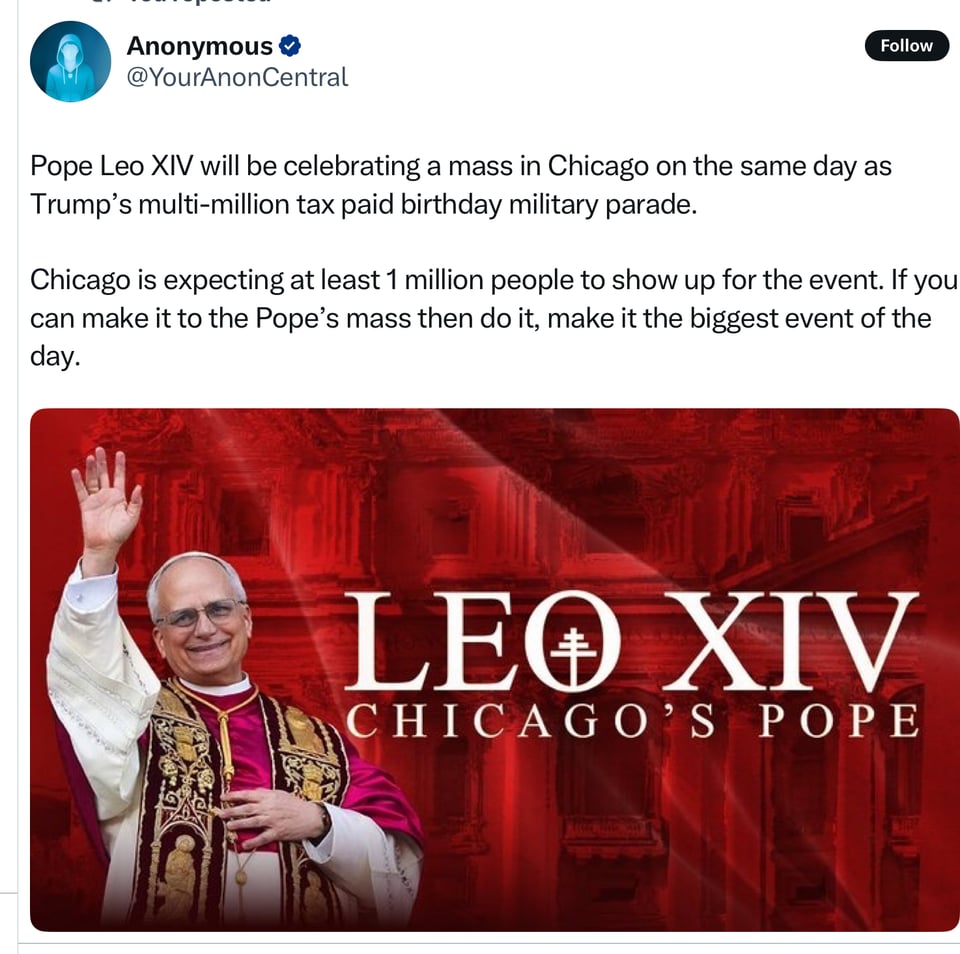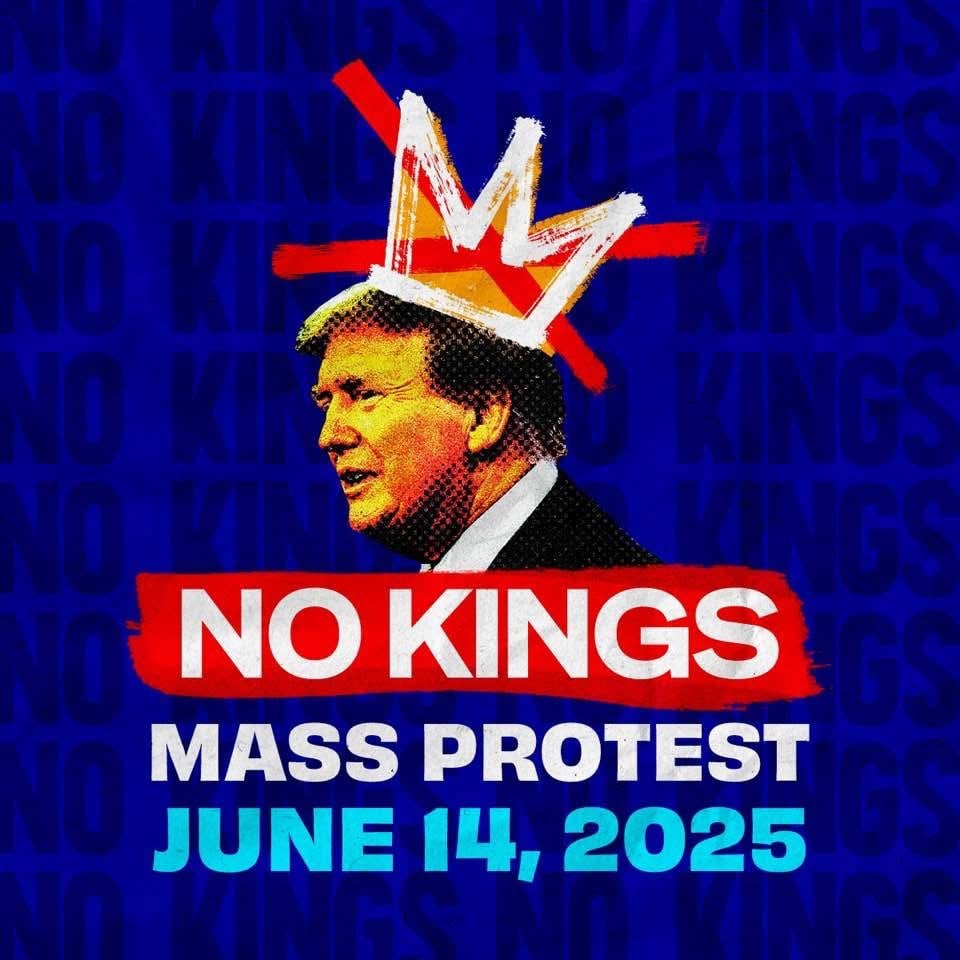Tuesday, June 3, 2025. Annette’s Roundup for Democracy.
More resistance.
A Fiery Brief Fueled by Conservatives Helped Put Trump’s Tariffs in Peril.
A coalition including leading figures on the right said the president’s program did violence to the Constitution. One judge cited it eight times.
A powerful sign that President Trump’s tariff-driven trade war is at risk came in a friend-of-the-court brief filed in April by a coalition that included many prominent conservative and libertarian lawyers, scholars and former officials.
The brief was also a signal of a deepening rift between Mr. Trump and the conservative legal movement, one that burst into public view last week with the president’s attacks on the Federalist Society, whose leaders helped pick the judges and justices he nominated in his first term.
Among the people who signed the brief in the tariffs case was Richard Epstein, who teaches at New York University and is an influential libertarian legal scholar.
“You have to understand that the conservative movement is now, as an intellectual movement, consistently anti-Trump on most issues,” he said.
Others who signed the brief, filed in the U.S. Court of International Trade, included Steven G. Calabresi, a founder of the Federalist Society; Michael B. Mukasey, a former federal judge who served as attorney general under President George W. Bush; and three former Republican senators — George F. Allen, John C. Danforth and Chuck Hagel. The brief was signed by liberals, too, including Harold Koh, a former dean of Yale Law School.
“The brief unites big-name constitutional law scholars across the political spectrum in a way I have rarely seen,” said Ilya Somin, a law professor at George Mason University and a lawyer for a wine importer and other businesses that sued over the tariffs.
“I never would have expected to see Richard Epstein, Steve Calabresi and Harold Koh all on the same brief on a major issue,” he said. “But here they are, together, opposing ‘taxation by proclamation.’ Donald Trump brought them together.”
The brief was prepared by Michael W. McConnell, a former federal appeals court judge appointed by Mr. Bush who teaches at Stanford Law School, and Joshua A. Claybourn, a lawyer and historian. It said Mr. Trump’s program did violence to the constitutional structure.
“The powers to tax, to regulate commerce and to shape the nation’s economic course must remain with Congress,” the brief said. “They cannot drift silently into the hands of the president through inertia, inattention or creative readings of statutes never meant to grant such authority. That conviction is not partisan. It is constitutional. And it strikes at the heart of this case.”
The coalition filed a very similar brief in a second case, too, in the Federal District Court in Washington. On Wednesday, the trade court ruled for the challengers. On Thursday, the district court judge followed suit, citing the supporting brief eight times.
Professor McConnell said that the prominence of the amici curiae — the friends of the court — who signed the brief sent a message.
“Our hope is that the identity of the amicus parties will signal the gravity of the situation,” he said. “All are concerned about executive usurpation of control over taxation of trade, which the Constitution explicitly vests in Congress.”
Professor Koh, who served as a State Department official in the Obama administration, said some issues transcend partisanship.
“Despite our political differences, the amici easily agreed, as lawyers, that the president has exceeded his delegated statutory authorities,” he said. “By unilaterally imposing unlimited tariffs on worldwide goods, he has lawlessly usurped Congress’s exclusive powers to impose taxes and duties and to regulate foreign commerce.”
The brief said it took no position on the wisdom of the tariffs.
“Amici do not appear to defend or oppose any particular trade policy,” it said. “They file this brief because they believe the Constitution draws bright lines between legislative and executive power — and that those lines are being blurred in ways that threaten democratic accountability itself.”
Professor Epstein said he had been honored to sign what he called a magnificent document, one that boiled the dispute down to its essence.
“This case is not close,” he said. “There are cases that are vastly important that are easy.”
Other scholars have offered more cautious assessments. Jack Goldsmith, a law professor at Harvard who was a Justice Department official in the Bush administration, recently wrote that the legal issues in the case were “hard and close.”
Karoline Leavitt, the White House press secretary, went further. “The president’s rationale for imposing these powerful tariffs was legally sound and grounded in common sense,” she said at a briefing last week.
An appeals court has temporarily paused the trade court’s ruling and will consider whether to extend that pause in the coming days. There is little doubt that the case will reach the Supreme Court, and soon.
When it does, the justices will have to grapple with two doctrines dear to the conservative legal movement, both of which would seem to cut against Mr. Trump’s understanding of his powers.
One, the nondelegation doctrine, says that Congress may not transfer unbounded legislative powers to the executive branch. The other, the major questions doctrine, says Congress must authorize in plain and direct language any sweeping executive actions that could transform the economy.
The friend-of-the-court brief said those doctrines, grounded in the separation of powers, required courts to reject Mr. Trump’s program.
“This case presents the court with a choice — not between competing trade policies, but between rival understandings of constitutional governance,” the brief said. “One preserves the balance the framers struck, requiring that major economic decisions receive explicit legislative authorization. The other would allow the executive to unilaterally remake the nation’s commercial framework under vague and general statutory language never intended to support such action.”
“The court,” the brief said, “should choose the former.” (New York Times).
One more thing.
As long as Trump can impose tariffs on everyone, he feels strong, believes he is KING, ruler of the nation and the world - hurting those he wants to hurt, giving relief to those who grovel and bend to his control.
When this power seems to be slipping between his little tiny fingers, he grows hysterical as these examples 👇 of his rants show.
Here he attacks Leonard Leo, longtime vice president of the Federalist Society who is currently co-chairman of its board of directors.“ Leo literally raised billions to help elect Trump, but even more than that, as legal analyst Jeffrey Toobin wrote in 2017, Leo was "responsible, to a considerable extent, for one third of the justices on the Supreme Court.”
This split with the Federalist Society, creator too of Project 2025, may or may not have legs going forward, but it could be the start of something wonderful. Remember you saw it here.
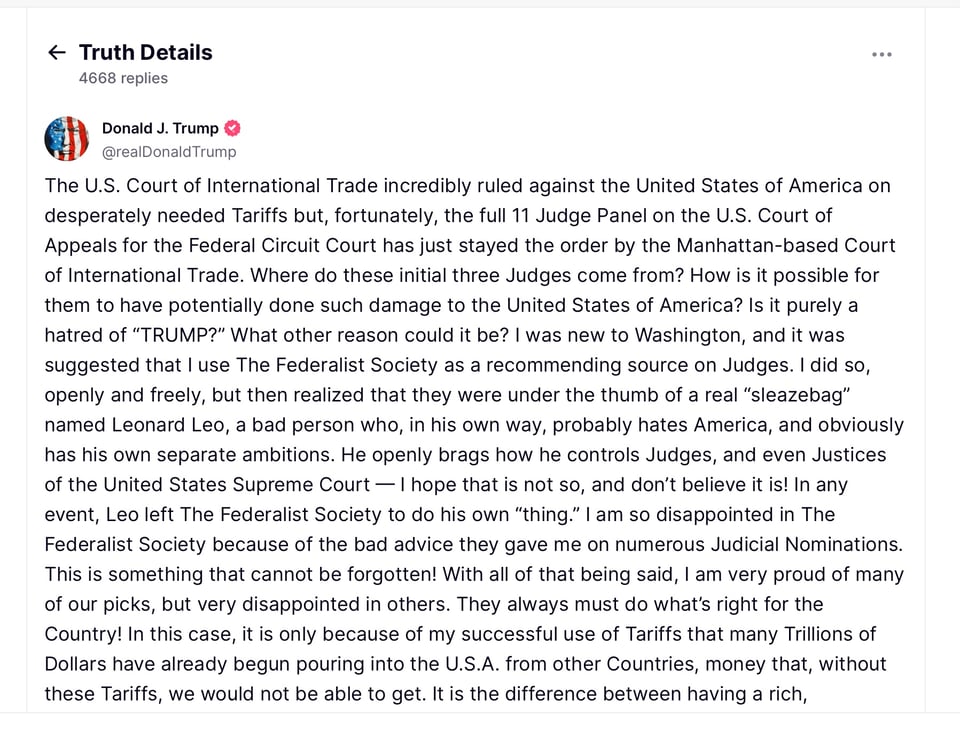
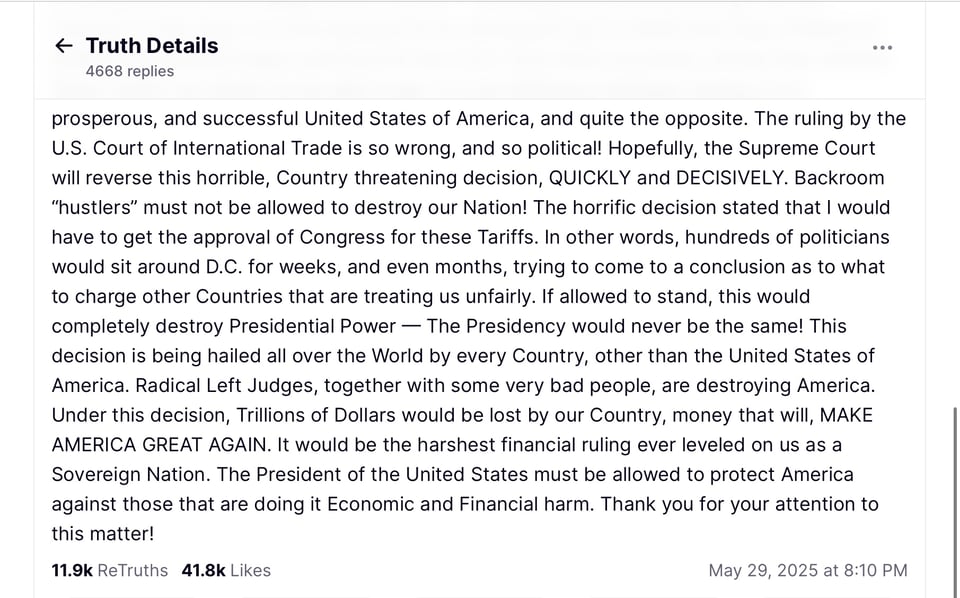
The rants continue.
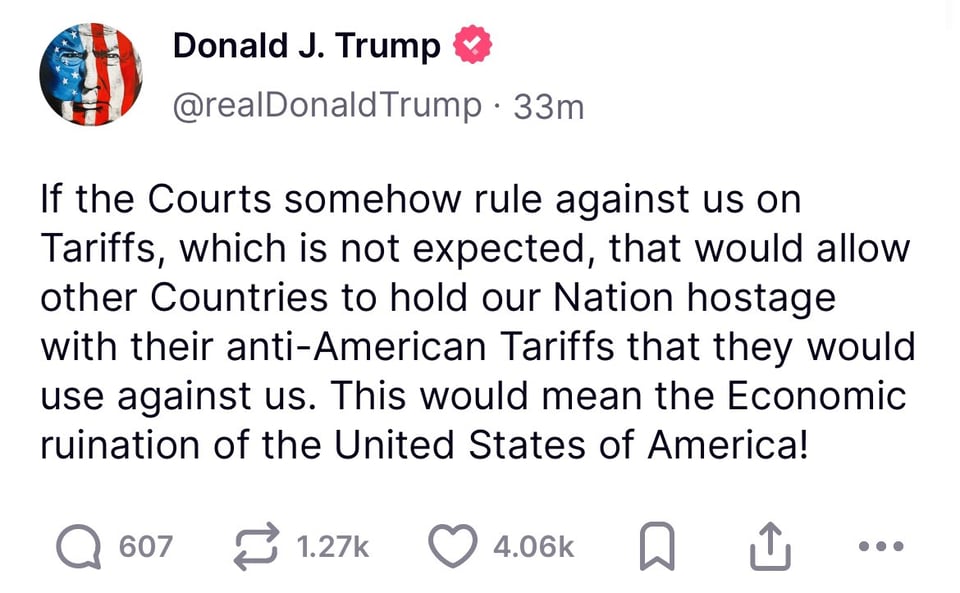
Glad some are waking up and rejecting “Originalism” as a rational approach to the law.
The mad tenet of “Originalism.”
The theory of constitutional interpretation that holds that the Constitution should be interpreted based on its original meaning at the time the Constitution was adopted, even if the issues of the Law being considered are about issues or products that didn’t exist at that time.
Why “Originalism”is mad.
Unless you believe in the accuracy of your abilities as a mind reader, how can you be sure you know what a founding father thought in 1776? And why on earth would you use his thoughts from 1776 as a standard for determining how Americans should live in 2025? And why would our law schools hire people to teach because they advocate or claim expertise based on such nonsense? And yet, interpretations of American law have been based on “originalism” for decades.
Finally, some are waking up and objecting.
HOW A RADICAL IDEOLOGY INFECTED THE SUPREME COURT AND POISONED THE COUNTRY.
Originalism, a framework with roots in the segregationist past and funded by right-wing oligarchs, helped lead to Donald Trump’s unconstitutional regime
An obscure ideology most people have never heard of is dominating almost every aspect of American life. Nearly every important Supreme Court ruling by the conservative majority — from abortion to voting rights, from gun control to environmental protection — virtually the whole far-right agenda — has been foisted on the nation using this ideology as its justification. “Originalism” is not a household word. Yet is in an extremely important word — the key to the political movement that has transformed the country over the last forty years and culminated in the regime of Donald Trump.
Originalism’s influence, once confined to the nation’s law schools, is now vast, reaching far beyond the Supreme Court majority’s politicized rulings. First and foremost, originalists — yes, they call themselves that —provide the intellectual underpinning for Trump’s “emergencies,” his lawless assault on law firms, universities, the Smithsonian, the Library of Congress, the Voice of America, indeed, the entire civil service. The grand alibi comes in the form of what the originalists present as the doctrine of “unitary executive,” a contrived theory of their own making that they pass off as something the Framers inscribed in the Constitution.
In justifying Trump issuing executive orders as though they were dictatorial decrees, the theory denies innumerable vital federal agencies and institutions the slightest independence. Most recently, on May 22, the Supreme Court moved to the brink of destroying that independence, trashing an 80-year old precedent in a preliminary ruling on the longstanding Humphrey’s Executor, and allowing the president more power to remove officials from independent organizations, and cloaking the pre-determined result in flimsy originalist explanations. As the “unitary executive,” Trump can threaten to place the Federal Reserve under his heel, which would likely trigger a worldwide Depression. The high court itself exposes originalism as the expedient fraud that it has always been. Left unchecked, originalism can be wielded as a tool to tear apart American democracy and menace the global economy.
Confusion surrounds originalism partly because it flies under many aliases, including “textualism,” “original meaning,” and “history and tradition.” Until recently, even the most influential elites in the legal establishment have had difficulty grasping the shifty, esoteric jurisprudence that has no particular historical claim to legitimacy but that now rules the federal judiciary.
Yet originalism does have a history. For decades, a dedicated and staggeringly well-funded movement of plutocrats and their right-wing allies has worked through shadow networks to capture and politicize the courts. How much money? Probably more than $2 billion. According to Senator Sheldon Whitehouse (D-R.I.) this operation spent $34 million in its campaigns against President Barack Obama’s choice for the Supreme Court, Merrick Garland, and to install Neil Gorsuch and Brett Kavanaugh on the court. That’s been money well-spent in the right-wing’s dark money operation. It’s won victory after victory in the courts, in every domain of law — from gun rights to abortion to environmental law and beyond. Originalism is the phony doctrine they invented to justify their rulings, confuse their opponents, and impose their political agenda.
So-called originalists like to pontificate with lofty pronouncements about what the Founders would have wanted — as though the Founders were unified in their vision, and as if that vision could be unequivocally divined from a vantage point 250 years later, from sparse documentary evidence by ideologues who cook the history books. And the Christian Nationalist wing of the originalists absurdly claim that the Founders intended to create a Christian nation, as though Thomas Jefferson and James Madison never spoke about the separation of church and state.
The originalists claim that they are serving a truly impartial jurisprudence, merely calling “balls and strikes,” in Chief Justice John Roberts’ phrase, based on a literal meaning of the Constitution. In fact, the record shows, glaringly, that the originalists work backwards from their goals to find the magic words to cloak their extremism. Facts and precedent be damned. Originalists bully their way forward using distorted and outright fabricated history, figuring that no one will call them out.
In short: Originalism is a dangerous fraud.
Dark Origins
Whatever its claims to historical grounding and omniscience, originalism is a comparatively new invention as an ideology. It was born as a direct political response to the Supreme Court’s landmark 1954 ruling, Brown v. Board of Education, declaring segregation in public schools to be unconstitutional.
Brown was an affront not just to Jim Crow southerners but to the broader conservative movement, exemplified by William F. Buckley Jr.’s then new magazine, National Review. The backlash drew from old ideas from before the Civil War in defense of slavery about states’ rights, to stop the implementation of federal laws, including equal justice under the law and especially voting rights, and, more boldly, to declare those laws unconstitutional. It’s a direct route from the segregationists’ arguments against civil rights to Chief Justice John Roberts’ ruling in 2013 eviscerating the Voting Rights Act of 1965. That may be the only true originalism.
It’s important to note that this reactionary movement was not confined to the political fringe. The spirit of constitutional originalism had existed, for many years, focused mainly on opposing the reforms of the New Deal. Having switched to responding to desegregation, the movement conservatives suddenly had to obfuscate the racist core of their position. Hiding their bigotry in the folds of history, they embarked on the project of supposedly discovering the original intent of the 14th Amendment, trying to show that its guarantee of equal protection under the law was irrelevant to securing civil rights for Black schoolchildren and their parents.
To undermine Brown, conservatives hit upon a slogan they dressed up as a judicial principle: “intent construct.” That was the first definition of what became originalism. To distract from the racist foundations of their resistance, they tried to shift attention from existing injustice to what the framers of the Constitution supposedly intended — the intent construct. As a leading pro-segregation journalist James J. Kilpatrick wrote: “In constitutional cases, the clock must always be turned back.” He was whistling “Dixie” or humming “Carry Me Back to Old Virginny.” Glossed over, of course, was the fact that “intent construct” meant that the conservatives on the bench would construct the framers’ intent, sometimes out of thin air.
With the seed planted against desegregation, the conservative movement — including William F. Buckley’s National Review, Barry Goldwater, and Ronald Reagan — nurtured and grew the project of what would became known as originalism.
The most important figure in defining originalism was Robert Bork, who as Richard Nixon’s acting Attorney General tried to suppress the Watergate investigation in the notorious Saturday Night Massacre in which, on President Nixon’s order, he fired the special prosecutor in 1973. Bork had proposed, two years earlier, what would become an influential outline of originalism in an article for the Yale Law Journal. He argued that judges should be able to discover what the framers “actually intended” from “text or history,” without inserting their own interpretation. Funnily enough, in Bork’s originalism, the Framers always supported what the contemporary right-wing wanted at any given moment.
When President Reagan nominated Bork to the Supreme Court in 1987, the Senate rejected him as too extreme. Yet if Bork’s nomination failed, the ideas he propagated had already gained momentum. (The fight over Bork’s botched nomination gave birth to a new verb — “borked” — which has been used to describe every failed nomination since and marked the beginning of vicious partisan fighting over Supreme Court seats.)
In 1985, President Reagan’s Attorney-General Edwin Meese — soon to be disgraced in a financial scandal and forced to leave office — addressed the American Bar Association, professing that the “intended role“ of the judiciary was to serve as “bulwarks of a limited constitution.” Judges and justices, he argued, should be expected to “resist any political effort to depart from the literal provisions” of the Constitution and “press for a Jurisprudence of Original Intention.” Meese and the originalists concealed that “Original Intention” meant intention as construed by themselves, the originalists.
What these ideological inventors left unstated was the inconvenient fact that the Framers themselves believed that the Constitution’s words should not become a kind of scripture but instead serve as the basis for guarding freedom and rights while pursuing the general welfare, evolving along with the nation. The Framers endlessly disparaged the idea of an unchangeable fundamentalist text. “In framing a system which we wish to last for ages, we should not lose sight of the changes that ages will produce,” James Madison said during the Constitutional Convention. In a debate in the House of Representatives, on April 6, 1796, Madison declared, “…whatever veneration might be entertained for the body of men who formed our Constitution, the sense of that body could never be regarded as the oracular guide in expounding the Constitution.” But the originalists ignore the practical sense of the Framers as they claim to conduct seances hearing their true voices from the beyond.
Antonin Scalia, appointed by Reagan to the Supreme Court in 1986, became originalism’s most visible and vocal proponent on the court. Originalism also became the creed of the Federalist Society, an organization of conservative academics that morphed into a hugely influential elite right-wing legal and political operation, grooming hundreds of lawyers for appointment to the federal bench, a vast machinery to take over the judiciary and the law financed by the many millions of dollars gathered and administered by the reactionary theocrat Leonard Leo, who assumed control of a $1.6 billion slush fund in recent years. Although originalism was then a newly minted concept, which would have been inconceivable to the Founders, within 15 years it had managed to seize the political high ground and masquerade as history.
In 2000, in one of the crudest but most consequential maneuvers in American history, Scalia led a conservative majority on the court, in a 5-4 decision, to hand the presidency to the Republican candidate, George W. Bush, by stopping the counting of thousands of ballots in the Florida contest. Scalia, in a bit of originalist jiu-jitsu, flipped the 14th Amendment’s “equal protection” clause to declare Bush the winner — a ruling Scalia reportedly confessed in private later was “as we say in Brooklyn, a piece of shit.”
Twisting of History
The basic conceits of originalism are deceptively simple: The meaning of the Constitutional text was fixed, knowable, and unambiguous at the time it was written; and that this meaning should govern for all time. To these absurd presumptions the originalists add one more: that only originalists can dictate the law.
The real trick for them is to find language that is roomy enough to embrace their pre-arranged goals but also narrow enough to avoid sounding obviously contrived. Contrary to the humbug of what originalists would have you believe, the Founders did not have a unified vision. Madison believed that even the meaning of words in the Constitution acquired different definitions over time. “What a metamorphosis would be produced in the code of law if all its ancient phraseology were to be taken in its modern sense,” he stated in 1824.
But it’s easy enough to manipulate historical sounding language into a single, clear-cut “original” meaning and then arrive at an interpretation of that meaning that justifies the desired conclusions. Intended to have a gravity not unlike fundamentalist Biblical exegesis, it more closely resembles three-card monte.
Such historical distortion and falsehoods, for example, form the cornerstone of the court’s decision in Dobbs v. Jackson Women’s Health Organization, the case that overturned Roe v. Wade and eliminated federal protections for abortion rights.
Among the central assertions in that decision, written by Justice Samuel Alito, concerned what Alito called a “most important historical fact” — that 28 out of 37 states banned abortion throughout pregnancy at the time of the ratification of the 14th Amendment (the basis for Roe) in 1868. Historians quickly noted that Alito’s claim was spurious: At least seven of the 28 states he claimed had completely banned all forms of abortion actually permitted them in some form. Roe finally fell in 2022, a victim of bad faith “originalist” history, and women were deprived of a basic right to reproductive freedom and health.
Alito is not alone on the Supreme Court bench in warping the historical record. At this point, one critic observes, “distorting the past to further his ideological agenda has become a trademark feature” of Justice Clarence Thomas. Thomas’ majority decision in New York State Rifle & Pistol Association v. Bruen, struck down a New York law that required persons to obtain an unrestricted license to carry a concealed firearm. The defense, along with amicus curiae briefs, cited numerous Reconstruction-era gun regulations as precedents for the restriction law. Thomas dismissed these as “outliers” and placed far greater weight on how, he said, English peasants during the 1500s carried guns. Now, English highwaymen of the 16th century were as good as the Framers for originalist precedent.
Thomas’ decision rested on Scalia’s originalist formulation in District of Columbia v. Heller, in 2008, in which he extended the Second Amendment, applying to members of militias (today’s National Guard), to an unqualified right for gun ownership for every individual. Thomas, however, took originalism beyond any hitherto limits, claiming that any and all gun control had to be able to cite an analogy to a regulation on an originalist basis to be valid.
In 303 Creative LLC v. Elenis, the Supreme Court showed just how far it is willing to go in ignoring the facts by fabricating the recent past as well as history. The majority ruling, written by Justice Gorsuch, held that a wedding website designer was entitled to discriminate against a gay couple because the Colorado law which prohibited her from doing so violated her First Amendment rights. The entire case was a scam. One day before the court’s opinion was published, The New Republic reported that the facts had been fabricated. The designer had never been asked to make a “gay” cake; the religious right had engineered the complaint in order to bring a test case to the Supreme Court. Gorsuch’s ruling, meanwhile rested on another assertion of false history: that religious speech has always occupied an unimpeachably privileged position in American law. With that, he stomped on the principle of the separation of church and state fervently advocated by Thomas Jefferson and James Madison, and which is enshrined in the Constitution’s “establishment clause” prohibiting government support for religion of any sort.
Fighting Back
Originalism has succeeded in insinuating itself into law and politics at every level. It has featured in every Republican Party platform from 1992 to 2016, except in 2004. At least five of the nine Supreme Court justices explicitly espouse it, and the rest are required to engage it as legitimate legal theory. It has taken hold everywhere from the Courts of Appeal to state courts through appointments of right-wing judges.
By now, any U.S. citizen engaged in civic life knows about Project 2025. Despite Trump’s ludicrous protest that he was not involved with the project and knew nothing about it, many of the major policies it describes have either been implemented already by the Trump regime since January or are in the pipeline. Many of the contributing authors of Project 2025 are originalists. The fingerprints of originalism are everywhere in this plan, which makes sense: Project 2025 aims to remake the whole of American law, politics, and social life in a radical right-wing mold.
Originalism doesn’t do what it claims to do, and some judges try to fight it on its own terms. Judge Beryl Howell, the chief judge on the federal D.C. Circuit recently used originalist reasoning to hold that the Trump administration’s unitary executive theory is invalid — pitting originalism ironically against originalism. She wrote that “the Framers made clear that no one in our system of government was meant to be king — the President included — and not just in name only.” And yet Trump insists he can be a dictator. His originalist ideologues bestow on him vast and unchecked powers, the unitary executive.
To help cut through the fog of originalist propaganda, too often taken at face value in news reporting and public debate, we established in 2023 what we call the Court of History, appealing to what is, after all, the highest court of all. We have exposed the originalist fraud, through news articles, webinars, and conferences. We have revealed the insidious use of this concocted doctrine to justify a far-right agenda. And we have unmasked the underlying theocratic movement of Christian Nationalism to leverage originalism for its cultish ambitions. Since the 2024 election, we have expanded our mission to address the illegalities and unconstitutional outrages of the Trump regime; and we have extended our reach to become a podcast on the Legal AF network. We believe that the beginning of the defense of American democracy is to explain fearlessly the Trump regime’s catastrophic assault on constitutional rights, the rule of law, and a government that serves the people. It will take much more work before the curse of originalism is dispelled.
Starting in the farther fringes of the segregated South and right-wing radicalism, originalism is at the center of the conservative project. Far from an abstract game of legal reasoning, originalism has real and devastating consequences. Donald Trump has become the essential implementer of their gameplan to force through Project 2025 and pack the courts with originalist judges. But as the nation approaches the 250th anniversary of the American Revolution, we can only wonder what bizarre twisting of history the originalists will invent to justify a tyrannical regime.
Sean Wilentz, the author of, among many books, The Rise of American Democracy, teaches at Princeton and is a regular contributor to Rolling Stone.
Sidney Blumenthal, a former White House advisor to president Bill Clinton, is a journalist and historian and the author of a continuing biography of Abraham Lincoln.
Rolling Stone.
A Major Gun Control Victory. Really.
Supreme Court allows AR-15 ban in this state - ABC News

AR-15 rifles are displayed at an exhibition booth during the National Rifle Association annual convention in Dallas, Texas, May 18,
The Supreme Court on Monday turned away an appeal by a group of gun-rights advocates seeking to overturn Maryland's ban on assault-style rifles and high-capacity magazines under the Second Amendment.
The decision, a major win for gun-safety advocates, leaves in place a ruling by the Fourth Circuit U.S. Court of Appeals which ruled that the state may constitutionally prohibit sale and possession of the weapons.
The state legislation, enacted in 2013 after the Sandy Hook elementary school shooting, specifically targets the AR-15 -- the most popular rifle in America with 20-30 million in circulation. They are legal in 41 of the 50 states.
Justices Samuel Alito, Neil Gorsuch and Clarence Thomas dissented from the decision, saying they would have taken up the case to decide the issue nationwide. Legal challenges to other state bans remain pending in lower courts.
"I would not wait to decide whether the government can ban the most popular rifle in America," Justice Thomas wrote. "The question is of critical importance to tens of millions of law-abiding AR-15 owners throughout the country."
Justice Brett Kavanaugh agreed with the court's decision to let the Maryland law stand, for now, but wrote separately to call the appeals court ruling "questionable." Kavanaugh said that he expects the high court to weigh in formally on the legality of the AR-15 in the "next term or two."
Maryland has seen a decline in gun violence since the enactment of a series of laws aimed at curbing access to dangerous weapons.
Officials particularly credit a series of federal, state and local restrictions imposed on gun kits in 2022 and 2023 with slowing online sales of untraceable firearms, requiring background and age checks of buyers and banning some kit sales in Maryland altogether.
While the Supreme Court's conservative majority has issued rulings expanding the rights of gun owners, recent decisions have underscored support for some longstanding restrictions. In June 2024, the high court upheld a ban on firearm purchases and possession by Americans under domestic violence restraining orders. Earlier this year the Court also upheld federal regulations targeting ghost guns. (ABC News).
Eve keeps asking why hasn’t Trump ended Juneteenth celebrations yet.
I answer, Who knows. Meanwhile this is happening.👇
Juneteenth celebration expands despite civil rights backlash
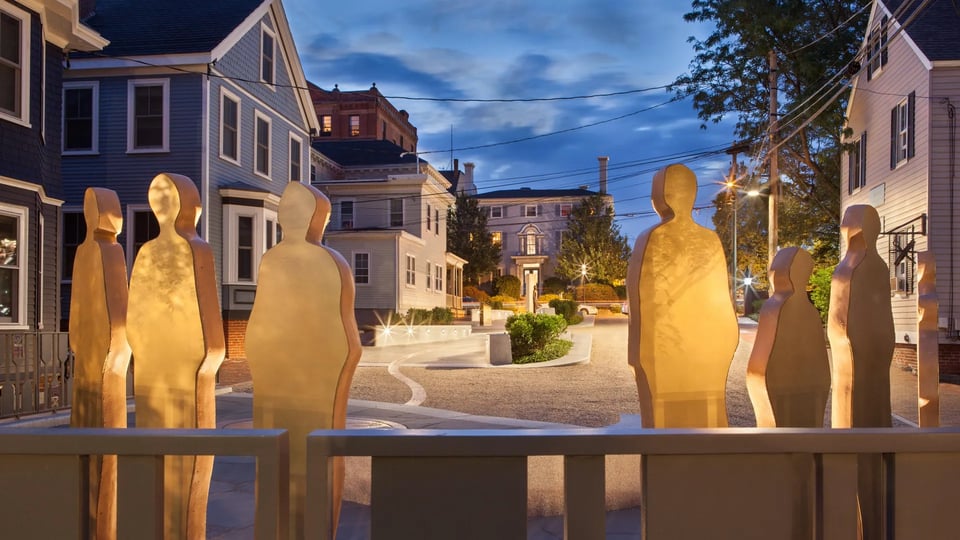
Portsmouth African Burying Ground Memorial, which honors more than 200 enslaved people whose graves were paved over and forgotten until their accidental rediscovery during road construction in 2003, in Portsmouth. N.H. Photo: Courtesy of Black Heritage Trail of New Hampshire.
Celebrations of Juneteenth, the new federal holiday that honors the emancipation of enslaved people in Texas, are growing amid a general backlash on civil rights and discussions on racism.
Why it matters: Like Pride, companies are pulling back of diversity, equity and inclusion initiatives around race, and the Trump administration reinterprets Civil Rights-era laws to focus on "anti-white racism."
But the popularity of Juneteenth and the momentum around the holiday appears to help it expand around the country — for now.
Zoom out: Portsmouth, the New Hampshire city where an enslaved woman escaped President George Washington's pursuit, will host a gathering for Juneteenth of direct descendants of some of America's founding fathers and the people they enslaved.
Oakland, Calif.-based Red Bay Coffee will release this month a "Juneteenth Limited Release" coffee named Intango Rwanda, a light-medium roast grown high in the hills of Gatagara Village by the Dukunde Kawa Cooperative.
The Library of Congress commemorate Juneteenth with a "program focused on the themes of family and home." The library will encourage visitors to meet a staff expert from the Manuscript Division, and learn about items from the Library's Abraham Lincoln Papers.
Organizers in Houston, north of Galveston, Texas, the site of the original Juneteenth, will host a series of events including a cook-off and a tour of historic Black neighborhoods.
Portland, Ore., will play host to another Black rodeo on Juneteenth.
State of play: The rapid commercialization of Juneteenth comes as some states pass laws limiting the discussion about enslavement in public schools and as some GOP lawmakers press for the return of Confederate monuments.
Catch up quick: This is the fourth year that Juneteenth has been a national holiday since President Biden signed legislation in 2021.
It commemorates June 19, 1865 — the day Union Maj. Gen. Gordon Granger rode into Galveston, Texas, with words that the Emancipation Proclamation had been signed by President Lincoln more than two years before.
What they're saying: "Juneteenth is a reckoning and allows us to give the country another narrative," JerriAnne Boggis, executive director of the Black Heritage Trail of New Hampshire, told Axios.
Boggis said it's also a time to remind the country of important allyships between white and Black Americans that helped to end enslavement.
The
"That's part of the story," she said.
Zoom in: From June 8-19, artists, historians and community leaders will gather for a 10-day series of walking tours, dedications, talks and film screenings in New Hampshire, a sign of how far Juneteenth are spread.
Organized by the Black Heritage Trail of New Hampshire, the events will be held in Portsmouth, where Ona Judge, an enslaved woman in President Washington's household, escaped to freedom and defied recapture.
The events will include a conversation with Laurel Guild Yancey, descendant of Portsmouth's Prince Whipple – a Black man who fought in the Revolutionary War while enslaved by Declaration of Independence signer William Whipple.
Bottom line: Juneteenth continues to evolve and expand across the country, finding support to grow.
Happy Juneteenth. Happy Pride too.

And keep this is mind.
